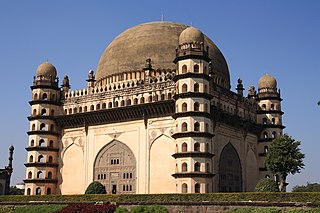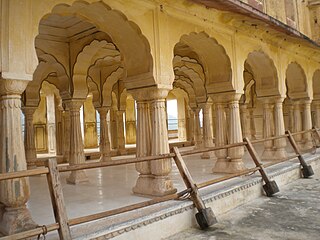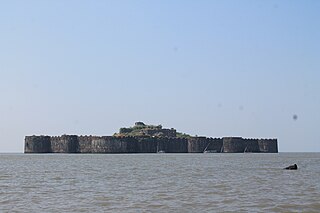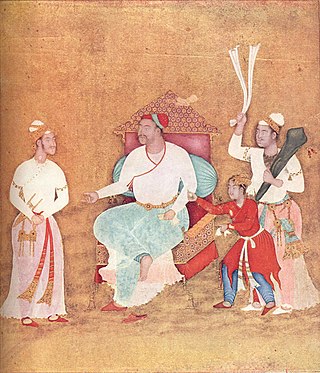| Yogini with a Mynah Bird | |
|---|---|
 | |
| Dimensions | 44 cm× 32 cm(17 in× 13 in) [1] |
| Location | Chester Beatty Library, Dublin |
Yogini with a Mynah Bird is a Deccan-styled painting located in the Chester Beatty Library. [1]
| Yogini with a Mynah Bird | |
|---|---|
 | |
| Dimensions | 44 cm× 32 cm(17 in× 13 in) [1] |
| Location | Chester Beatty Library, Dublin |
Yogini with a Mynah Bird is a Deccan-styled painting located in the Chester Beatty Library. [1]
It is dated to the early 17th century, and presumably commissioned for the court of Ibrahim Adil Shah II. [1] [2]
The principal subject is a woman, who has the characteristic features of a yogini, with ash-coloured skin and top-knotted hair. She is wearing a red peshwaj , with a golden dupatta and gold jewellery. [3] [4] A myna bird is perched upon her right hand. [2]
On either side of the woman are lotus and peony plants, the design of which was likely copied from Chinese porcelain or textiles. [1] In the background is a golden sky, beneath which are rocks characteristic of the Deccan, and a hill, atop which is a palace. The painting is surrounded by poetic texts in Persian, on all four sides. [2] [5] [6]

The woman's appearance gives rise to conflicting interpretations. Her top-knotted hair and ash-besmeared skin identify her as a yogini. The elongated shape of her body also points toward her status as an ascetic, as her leanness may be due to fasting. [2]
However, her attire consisting of the peshwaj , golden dupatta , and lavish gold jewellery suggest that she belongs to the aristocracy. In South Asian literature, myna birds are associated with noble ladies, who keep them as pets. The palace in the background gives rise to the interpretation that she has left behind her past life. [3] [4] [7]
This depiction of princess-like yoginis is common in Deccan art. Examples of this include a painting in the Jagdish and Kamla Mittal Museum. [8]
Mark Zebrowski interprets her to be a sorceress. He describes her face as "Medusa-like" and points out that the bird could represent an ill omen. He says that the dark theme of the painting may represent the "seductive heresies" that enticed Ibrahim II away from orthodox Islam. [note 1] [9] [10]

The Deccan sultanates is a historiographical term referring to five late medieval to early modern Indian kingdoms on the Deccan Plateau between the Krishna River and the Vindhya Range that were created from the disintegration of the Bahmani Sultanate and ruled by Muslim dynasties: namely Ahmadnagar, Berar, Bidar, Bijapur, and Golconda. The five sultanates owed their existence to the declaration of independence of Ahmadnagar in 1490, which was followed by Bijapur and Berar in the same year. Bidar became independent in c. 1492, and Golconda in 1512.

Gol Gumbaz, also written Gol Gumbad, is a 17th-century mausoleum located in Bijapur, a city in Karnataka, India. It houses the remains of Mohammad Adil Shah, seventh sultan of the Adil Shahi dynasty, and some of his relatives. Begun in the mid-17th century, the structure never reached completion. The mausoleum is notable for its scale and exceptionally large dome. The structure is an important example of Adil Shahi architecture.

The Sultanate of Bijapur was an early modern kingdom in the western Deccan and South India, ruled by the Adil Shahi dynasty. Bijapur had been a taraf (province) of the Bahmani Kingdom prior to its independence in 1490 and before the kingdom's political decline in the last quarter of the 15th century. It was one of the Deccan sultanates, the collective name of the kingdom's five successor states. The Sultanate of Bijapur was one of the most powerful states on the Indian Subcontinent at its peak, second to the Mughal Empire which conquered it in 1686 under Aurangzeb.

Farrukh Beg, also known as Farrukh Husayn, was a Persian miniature painter, who spent a bulk of his career in Safavid Iran and Mughal India, praised by Mughal Emperor Jahangir as "unrivaled in the age."
Ibrahim Adil Shah I was sultan of the Indian Sultanate of Bijapur. He succeeded his elder brother, Mallu Adil Shah, through the machinations of the Afaqi faction at the court. He was the first Adil Shahi ruler to assume the royal title of Shah.

The toshakhana was originally a Mughal place where princes store "gifts and emblems of honor that they received for their posterity ... an archive of objects whose origin and receipt embodied his status and honor" The term is of Persian origin that literally translates as "treasure house".
Nauraspur was a city in what is today Karnataka, India. It was founded in 1599 by Ibrahim Adil Shah II, the sultan of the Bijapur Sultanate. It was destroyed in 1624 by Burhan Nizam Shah III, then sultan of the Ahmednagar Sultanate, which were the Adil Shahis' greatest rival and also a member of the Deccan Sultanates.

The Deccan sultanates were five early modern kingdoms, namely Bijapur, Golkonda, Ahmadnagar, Bidar, and Berar, which ruled the Deccan Plateau for part of the 15th, and the majority of the 16th–17th centuries. Their architecture was a regional variant of Indo-Islamic architecture, and influenced by the styles of the Delhi Sultanate and later Mughal architecture, but sometimes also influenced from Persia and Central Asia. Hindu temple architecture in the same areas had very different styles.

The Deccanis or Deccani people are an Indo-Aryan ethno-religious community of Deccani-speaking Muslims who inhabit or are from the Deccan region of India. The community traces its origins to the shifting of the Delhi Sultanate's capital from Delhi to Daulatabad in 1327 during the reign of Muhammad bin Tughluq. Further ancestry can also be traced from immigrant Muslims referred to as Afaqis, also known as Pardesis who came from Central Asia, Iraq and Iran and had settled in the Deccan region during the Bahmani Sultanate (1347). The migration of Muslim Hindavi-speaking people to the Deccan and intermarriage with the local Hindus who converted to Islam, led to the creation of a new community of Hindustani-speaking Muslims, known as the Deccani, who would come to play an important role in the politics of the Deccan. Their language, Deccani, emerged as a language of linguistic prestige and culture during the Bahmani Sultanate, further evolving in the Deccan Sultanates.

Deccan painting or Deccani painting is the form of Indian miniature painting produced in the Deccan region of Central India, in the various Muslim capitals of the Deccan sultanates that emerged from the break-up of the Bahmani Sultanate by 1520. These were Bijapur, Golkonda, Ahmadnagar, Bidar, and Berar. The main period was between the late 16th century and the mid-17th, with something of a revival in the mid-18th century, by then centred on Hyderabad.
Viceroy of the Deccan was the representative of the Mughal emperors in Deccan, Deccan consisted of six Mughal governorates (Subah): Khandesh, Bijapur, Berar, Aurangabad, Hyderabad and Bidar. Carnatic region was a subdivision which was partly administered by the governor of Bijapur and Hyderabad.
Peshwaj was a ladies outfit similar to a gown or jama coat with front open, tied around the waist, having full sleeves, and the length was full neck to heels. Peshwaj was one of the magnificent costumes of the mughal court ladies. The material was used to be sheer and fine muslins with decorated borders of zari and lacework.
Navina Najat Haidar is an art historian and curator, and currently serves as the chief curator of Islamic art at the Metropolitan Museum of Art in New York.
Khadija Sultana was the regent of the Bijapur Sultanate between 1656 and 1661.

The Gulshan-i 'Ishq is a romantic poem written in 1657 by the Indian Sufi poet Nusrati. Written in the Deccani language, it combines literary and cultural traditions from India and Iran. It describes the journey of a prince through a series of fantastical scenes in search of a woman he saw in a dream, leading to their union in a rose garden. Manuscripts of the poem, illustrated with lavish paintings, have survived from the 18th century to the present day.

Muḥammad Nuṣrat, called Nuṣratī ('victorious'), was a Deccani Urdu poet.

Golconda painting refers to the school of miniature painting developed during the reign of the Golconda Sultanate. It is itself a type of Deccan painting, and closely related to other Deccan schools, such as Bijapur and Ahmednagar.

The House of Bijapur is a 17th-century Deccan-style painting, commissioned during the Bijapur Sultanate. It is currently housed in the Metropolitan Museum of Art in New York City.

Pem Nem is a 16th-century manuscript commissioned at the court of the Bijapur Sultanate. It belongs to the Prem Marg genre of Sufi literature, where a love story forms a metaphor representing the quest for the union with God. Written in an early form of Dakhni, it is a mathnawi, a long narrative poem written in rhyming couplets.

Kitab-i Nauras, also transliterated as Kitab-e-Nauras, is a 16th-century treatise written by Sultan Ibrahim Adil Shah II of Bijapur. It was written with the title Nauras, meaining Nine Rasas, but was named as Nauras Nama or Kitab-i Nauras later. It is a collection of 59 Manqabat Kalaam (song) and 17 couplets in the Deccani Urdu language.